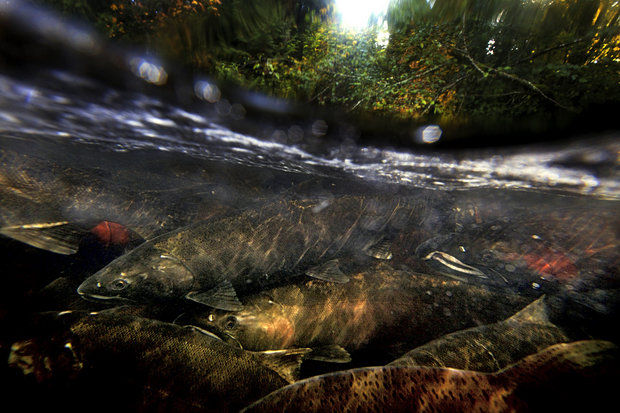forum
library
tutorial
contact

Study: Wild Coho Seek Genetic Diversity in
Mate Choice, Hatchery Fish Lack that Ability
by Staff
Columbia Basin Bulletin, May 30, 2014
|
the film forum library tutorial contact |

|
Study: Wild Coho Seek Genetic Diversity in
by Staff
|
Sport Fishing Re-Opens
 A new study by researchers at Oregon State University suggests that wild coho salmon that choose mates with disease-resistant genes different from their own are more likely to produce greater numbers of adult offspring returning to the river some three years later.
A new study by researchers at Oregon State University suggests that wild coho salmon that choose mates with disease-resistant genes different from their own are more likely to produce greater numbers of adult offspring returning to the river some three years later.
The researchers also found that hatchery-reared coho -- for some unknown reason -- do not appear to have the same ability to select mates that are genetically diverse, which may, in part, explain their comparative lower reproductive success.
Results of the study have been published in this month's Canadian Journal of Fisheries and Aquatic Sciences at http://bit.ly/1is9ydT
Funding was provided by the Oregon Watershed Enhancement Board, The Coastal Oregon Marine Experiment Station, Oregon Sea Grant, and the Oregon legislature.
"This is the first study to examine mate choice among wild-spawning fish of both hatchery and wild origin, and the results suggest that greater diversity of immune genes between wild-born pairs of coho salmon may increase offspring survival," said Amelia Whitcomb, who did the research as a master's student at OSU and is lead author on the publication.
"These findings, along with future research, may have important implications for hatchery supplementation programs," added Whitcomb, who now works for the Washington Department of Fish and Wildlife.
The key appears to be a suite of genes that include the major histocompatibility complex, which initiates immune response and ultimately provides disease resistance. Other factors, including size and timing of return to fresh water, also determined mate pair reproductive success. MHC genes are well-studied in many organisms, including humans, and have been shown to play a role in how individuals choose mates.
The researchers used genetic parentage analysis to study mating events among adult coho salmon -- both wild-born and hatchery-reared -- that returned and spawned in a natural context in the Umpqua River in southern Oregon. Adult coho salmon were fin-clipped for genetic identification so they could be linked to their offspring, which returned as adults three years later.
The researchers then compared reproductive success, defined as the number of adult offspring returns, from three different categories of naturally spawning mate pairs: two wild parents, two hatchery-reared parents, and a hatchery-reared/wild parent pair.
The study found that wild fish that bred with other wild fish that had dissimilar MHC profiles had an increased success rate compared to wild fish pairings of similar MHC diversity. In addition, wild fish that mated with hatchery fish that had intermediate rates of dissimilarity also had greater reproductive success than wild fish mated with hatchery fish that had little MHC diversity, or the greatest MHC diversity.
However, the mate selection of hatchery-raised fish with other hatchery-raised fish appeared to be totally random, according to Michael Banks, director of the Cooperative Institute for Marine Resource Studies at OSU's Hatfield Marine Science Center, and co-author on the study. In other words, hatchery-raised fish didn't appear to select mates based on any kind of genetic profile, "an indiscretion that may ultimately be lowering their reproduction success."
"Evidence that the MHC is associated with mate choice is common in many species through chemical cues detected by olfaction," Banks said, "so it isn't necessarily surprising that selecting for MHC diversity would increase reproductive success in salmon as well. What is puzzling is why hatchery-raised fish appear to have lost that ability."
Kathleen O'Malley, an assistant professor of fisheries and wildlife at OSU and co-author on the study, cautioned that genetic diversity is just one factor in mate selection and reproductive success.
"The ocean is like a black box for salmon and many factors can play a role in their survival," said O'Malley, a geneticist with the Coastal Oregon Marine Experiment Station at OSU's Hatfield Center. "But the strength of this study is that it looks at the bottom line, which is what creates the best chance of success for salmon to produce offspring that survive to return as adults."
O'Malley said the next logical step in the research is to develop selective breeding strategies that better emulate mating strategies that occur in the wild and to learn whether new strategies can reduce the difference in reproductive success among hatchery-raised and wild fish.
learn more on topics covered in the film
see the video
read the script
learn the songs
discussion forum
